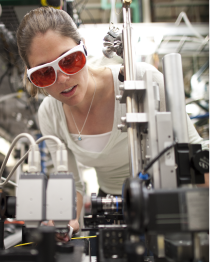
Date:
Location:
Title:
abstract
Synthesis of semiconductor compounds, alloys and heterostructures is often constrained by solubility limits, atomic diffusion and native defect formation, all of which can negatively impact the material properties and performance. Modern uses of semiconductors therefore depend on our ability to control these processes during growth. Some degree of control is typically achieved by tuning two parameters: temperature and chemical potential. Yet, there are many cases where additional degrees of freedom are desired. In this talk, I will discuss the application of a third process variable: excess photogenerated carrier populations. Non-equilibrium carrier concentrations are particularly useful, as they can be used to tune the quasi Fermi levels independently of extrinsic doping conditions, providing a way to further modify carrier exchange with defects, electric fields and desorption rates. I will detail our understanding of these mechanisms through the examples of 1) suppressing dopant diffusion in modulation-doped structures, 2) reducing native compensating defect concentrations, 3) altering Bi incorporation in GaAs and 4) forming III-V/II-VI hetero-interfaces. These examples may provide guidance for overcoming other growth challenges with light.
bio
Dr. Alberi received a B.S. in Materials Science and Engineering from the Massachusetts Institute of Technology in 2003 and a PhD in Materials Science and Engineering from the University of California, Berkeley in 2008, where she studied the optical and electronic properties of highly mismatched semiconductor alloys. She came to NREL as a postdoctoral researcher in the Silicon Materials and Devices group to investigate the design and performance of thin crystalline silicon (c-Si) solar cells fabricated on inexpensive substrates. In 2010, Kirstin joined the Materials Physics group to conduct basic research on the optical and electronic properties of semiconductor alloys for photovoltaic and solid-state lighting applications. Specific research interests include the molecular beam epitaxy, development of phosphide-based alloys for high-efficiency lighting, the physics of dilute nitride and bismide III-V alloys, and high-spatial resolution studies on minority carrier transport in thin-film photovoltaic materials.
Hosted by Kunal Mukherjee. Download event flyer.



